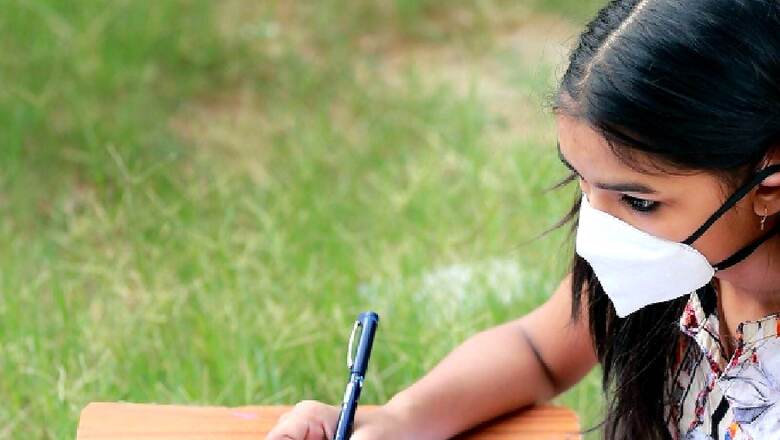
views
Schools have not opened for most parts of the last two years in India. As education is a concurrent subject between the Centre and the states, there has been a varying response to school reopening across the country. Some states did experiment with limited openings. However, at best, these openings were short, partial and woefully inadequate.
I’m a mum to a five-year-old who has been ‘zoom-schooled’ for more than 650 days. Last week her English class instruction was to write a few sentences describing her classroom, she stared blankly into her workbook and then asked me, “Mama, can you help me guess what my classroom looks like?” I did, it broke my heart but I suspect the damage done to her is far deeper. When she has to dance in front of a laptop screen for school classes but she can attend weddings with 200 guests, I have to pause and think, how did we get here?
Last August, I had written about how distorted incentives had locked us in the worst possible equilibrium of unending school closures where the three stakeholders namely parents, schools and children did not have adequate incentive to move out of the status quo. Given low levels of urban women workforce participation, the mothers had quickly shouldered the additional online-school burden, schools were comforted by fee protections granted by the Delhi High Court, and students were lulled by shortened syllabus, lack of rigorous offline tests and higher pass percentages.
Close to six months have passed since some of the dynamics are different.
Let’s start with schools. For simplicity, let us divide them into elite schools and budget schools. ASER study has shown that private school enrolment has dropped from 32.5 per cent in 2018 to 24.4 per cent in 2021. Some of these students are enrolling in government schools, while others have simply dropped out. Budget schools are impacted materially, staff has been laid off, dues are mounting and several will shut before the start of the new academic session in April 2022. Elite schools have not been as severely impacted as most parents have held onto their children’s seats and continued with near-full fee payment.
Moving on to children. Children in senior classes are no longer comfortable. They have had to appear for a new format of board examination at fairly short notice, cope with practicals without visiting school laboratories and deal with unclear examination timetables. Some of them have aspirations to study abroad and colleges are not all accepting of the smoothed-over grades for admissions and frankly, the children know that their global peers have not had this disadvantage and they will be starting higher education without that level playing field. They’re upset.
Middle and primary-year children are severely impacted but they continue to be voiceless. WHO, UNICEF, ICMR, top pediatricians and mental health experts have vehemently supported a school opening for all age groups without any vaccination mandates or milestones. This age group is voiceless and it is up to parents and educators to make their case.
Now coming to parents. If our women employment rate was 25-30 per cent particularly in urban areas, we would be sitting in a very different scenario (school opening would be a real election issue as women would need to return to their workplace). However, our urban women employment rate is a meager 5.4 per cent. I highlight urban as no one is listening to the parents in urban India leave alone rural India (Only 8 per cent of rural children on average have attended online classes, hence the entire online-school experiment has been an eye-wash for these students. What is shocking is that these students will be promoted to levels 2 years ahead to show high pass percentages and as a vast majority will find it hard to cope, they will drop out eventually. You cannot hide data – there’s always a trail). Women’s workforce participation in urban India has fallen further, they continue to shoulder the additional online-school responsibilities, mostly juggling two children while managing the house, a cruel and unfair burden.
With two years of school closure, we are now inching close to the number 1 spot in terms of the longest shutdown globally. This is shameful and sobering. I’m not going to dwell on the shameful part. It is sobering because this single act of our inability to connect the dots is going to be very costly.
I am laying out three arguments to outline the extent of the blow.
One, the losses on account of learning gaps. It has been estimated by the World Bank, that India is set to lose $440 billion in future earnings potential due to the learning losses, that’s roughly 17 per cent of the current GDP. Some of you may be sceptical about this calculation and feel that the loss may recover as children are back in classrooms. Fundamentally, it is extremely hard especially as instructional hours have declined across schools and government budgets towards education have fallen from 4.4 per cent of GDP in 2019 to 3.4 per cent more recently. To contextualise this, think of the set of graduates coming into the workforce who haven’t attended college for the last two years – these could be engineers or doctors, a field of study where there can’t possibly be any scope for 100 per cent online learning. Already the India Skill Report, 2021 has indicated that 1 of 2 Indian graduates are found to be employable – this will get significantly worse as we have pushed a cohort of under-equipped children up by two years to manage the system.
Two, several pediatricians and mental health experts have raised alarm around depression, technology addiction, obesity, rickets, and other ailments increasingly being reported in children, potentially linked to a sedentary mode of online school. These alone will knock off points from a productive workforce. India’s working-age cohort is projected to peak in 2031. In plain speak, the next nine years is the time when India should report blazing growth as we are fuelled by both productivity gains (which had already slowed pre-pandemic) as well as an increase in the number of people joining the workforce. If the young adults who join the workforce in the next nine years and particularly beyond have lower productivity, this is going to hamper growth.
Three, the biggest one with the deepest damage is the hit on women. Sharing with you some staggering data and what it is likely to mean for our growth.
CMIE (Centre for Monitoring Indian Economy) data shows that urban India has 22.1 per cent fewer women employed in 2021 than in 2019. Household income and savings potential are likely to be hit particularly, as expenditure on key categories including education rises (private school fees are being paid, 4 in 10 children are receiving private tuitions and opting for additional ed-tech driven top-up courses). India’s women workforce participation rates are substantially lower than neighbouring Bangladesh and Sri Lanka. So women have dropped out of the workforce, maybe some lost their jobs and others voluntarily dropped out? It’s happened before, what’s the big deal?
Now, the more worrying data point. The number of women looking for work in 2021 vs 2019 is down 34 per cent and the impact of the economic shock on younger women is higher (CMIE). This trend is seen in both rural and urban India and this can point towards a more long-term reversal in employment gains by women. If you are out of the workforce and not seeking work, it is going to be tougher to bring you back in at comparable levels. You don’t need to be a feminist to see the challenge this poses. No country’s growth estimates can be built off a model of declining women workforce participation.
Pre-pandemic, our birth rates had already fallen below the global average for the first time. Falling birth rates, is that good? Well, in pure demographic dividend terms, that’s not good news. It means growth is highly likely to slow with a potential to contract. Ruchir Sharma in his reporting of ‘10 big trends for the 2022 Economy’ has already pointed out that early data coming in from Mumbai is showing that the birth rate has declined sharply from 120 to 101 per 1000 residents. So frankly, if the data rolls in line with this and the total population (as well as the working-age population) doesn’t grow as per earlier estimates, consumption-led growth will be several notches lower than planned (or desired).
Is this causation or correlation? I don’t have an answer. I do have a hypothesis. I think we had a very unequal burden on women for home and child care pre-pandemic, what the pandemic did was push the women to a break-point and left us there for 650-plus days. Now you’re accustomed to seeing fewer women at work, fewer women seeking work, and more women managing additional responsibilities at home. We are basically disappearing. Now, it is a big deal.
Something’s got to give in this worst-case scenario where frankly all stakeholders are badly off. State governments seem to be mobilising some plans towards opening but it remains piecemeal, wrongly prioritised (senior classes first) and with unrealistic SOPs for schools to follow; for instance, they want buses to operate with 50 per cent capacity!
We can either correct this by removing distortion; for instance, let schools-students-parents decide on a future course of action, as a corollary the state governments should not interfere in school opening or fees protection. Essentially, let free markets reign. This can be problematic as we also have government schools and while private education you may argue is entirely a private good, there are several nuances to it.
A market failure of this proportion can only be corrected by a solid plan by governments. This is likely to require a coordinated response across states, we need a clear vision of how India plans to open its classrooms once again. As a parent, working mother and invested citizen, I sincerely hope that somebody’s going to help save the kids and put India back on its destined growth path.
If this does catch the attention of anyone who can decide or influence the decisions. My one message is to restore normalcy to children’s classrooms for all classes, with full working hours and transport solutions, without any vaccination-led milestones today.
Save us.
Simran Khara is a start-up founder. She is an alumnus of ISB, Hyderabad, London School of Economics (UK) and Shri Ram College of Commerce, Delhi University. The views expressed in this article are those of the author and do not represent the stand of this publication.
Read all the Latest Opinions here

















Comments
0 comment